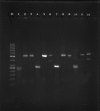Simple and Easy to Perform Preimplantation Genetic Diagnosis for β-thalassemia Major Using Combination of Conventional and Fluorescent Polymerase Chain Reaction
- PMID: 28401070
- PMCID: PMC5360017
- DOI: 10.4103/2277-9175.201682
Simple and Easy to Perform Preimplantation Genetic Diagnosis for β-thalassemia Major Using Combination of Conventional and Fluorescent Polymerase Chain Reaction
Abstract
Background: Thalassemias are the most common monogenic disorders in many countries throughout the world. The best practice to control the prevalence of the disease is prenatal diagnosis (PND) services. Extensive practicing of PND proved effective in reducing new cases but on the other side of this success high abortion rate is hided, which ethically unfair and for many couples, especially with a previous experience of a therapeutic abortion, or moral concerns, is not a suitable choice. Preimplantation genetic diagnosis (PGD) is a strong alternative to conventional PND. At present PGD is the only abortion free fetal diagnostic process. Considering the fact that there are more than 6000 single gene disorders affecting approximately 1 in 300 live-births, the medical need for PGD services is significant.
Materials and methods: In the present study development of a PGD protocol for a thalassemia trait couple using nested multiplex fluorescent polymerase chain reaction (PCR) for the combination of polymorphic linked short tandem repeat (STR) markers and thalassemia mutations is described. Restriction fragment length polymorphism used to discriminate between wild and mutated alleles.
Results: In PGD clinical cycle, paternal and maternal alleles for D11S988 and D11S1338 STR markers were segregated as it was expected. PCR product for IVSII-1 mutation was subsequently digested with BtscI restriction enzyme to differentiate normal allele from the mutant allele. The mother's mutation, being a comparatively large deletion, was detectable through size differences on agarose gel.
Conclusion: The optimized single cell protocol developed and evaluated in this study is a feasible approach for preimplantation diagnosis of β-thalassemia in our patients.
Keywords: nested fluorescent polymerase chain reaction; polymorphic markers; preimplantation genetic diagnosis; β-thalassemia.
Conflict of interest statement
There are no conflicts of interest.
Figures


Similar articles
-
[Successful preimplantation genetic diagnosis for beta-thalassemia using multiplex nested polymerase chain reaction].Zhonghua Yi Xue Za Zhi. 2005 Mar 30;85(12):811-5. Zhonghua Yi Xue Za Zhi. 2005. PMID: 15949396 Chinese.
-
Novel Multiplex Fluorescent PCR-Based Method for HLA Typing and Preimplantational Genetic Diagnosis of β-Thalassemia.Arch Med Res. 2016 May;47(4):293-8. doi: 10.1016/j.arcmed.2016.07.006. Arch Med Res. 2016. PMID: 27664489
-
Identification of novel microsatellite markers <1 Mb from the HBB gene and development of a single-tube pentadecaplex PCR panel of highly polymorphic markers for preimplantation genetic diagnosis of beta-thalassemia.Electrophoresis. 2015 Dec;36(23):2914-24. doi: 10.1002/elps.201500146. Epub 2015 Oct 5. Electrophoresis. 2015. PMID: 26331357
-
Preimplantation genetic diagnosis, an alternative to conventional prenatal diagnosis of the hemoglobinopathies.Int J Lab Hematol. 2013 Dec;35(6):571-9. doi: 10.1111/ijlh.12086. Epub 2013 Apr 3. Int J Lab Hematol. 2013. PMID: 23551498 Review.
-
Can preimplantation genetic diagnosis be used for monogenic endocrine diseases?J Pediatr Endocrinol Metab. 2019 Dec 18;32(12):1305-1310. doi: 10.1515/jpem-2019-0184. J Pediatr Endocrinol Metab. 2019. PMID: 31490775 Review.
References
-
- Hardison RC, Chui DH, Riemer CR, Miller W, Carver MF, Molchanova TP, et al. Access to a syllabus of human hemoglobin variants (1996) via the World Wide Web. Hemoglobin. 1998;22:113–27. - PubMed
-
- Olivieri NF. The beta-thalassemias. N Engl J Med. 1999;8(341):99–109. - PubMed
-
- Abolghasemi H, Amid A, Zeinali S, Radfar MH, Eshghi P, Rahiminejad MS, et al. Thalassemia in Iran: Epidemiology, prevention, and management. J Pediatr Hematol Oncol. 2007;29:233–8. - PubMed
-
- Liao C, Mo QH, Li J, Li LY, Huang YN, Hua L, et al. Carrier screening for alpha-and beta-thalassemia in pregnancy: The results of an 11-year prospective program in Guangzhou Maternal and Neonatal hospital. Prenat Diagn. 2005;25:163–71. - PubMed
LinkOut - more resources
Full Text Sources
Other Literature Sources
Miscellaneous

